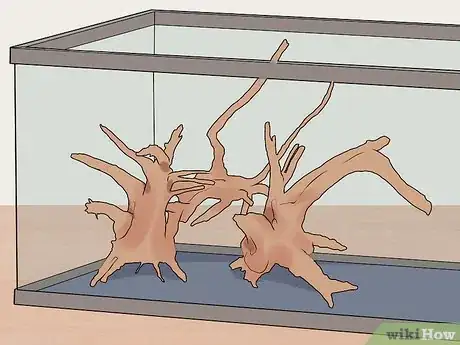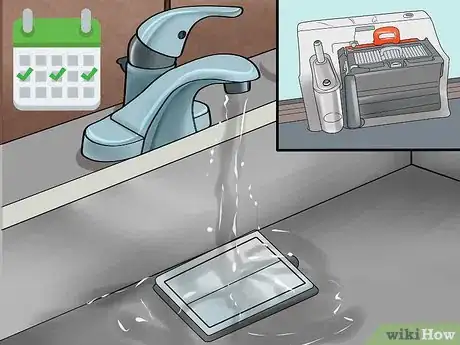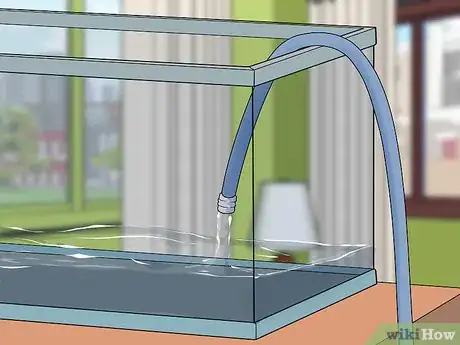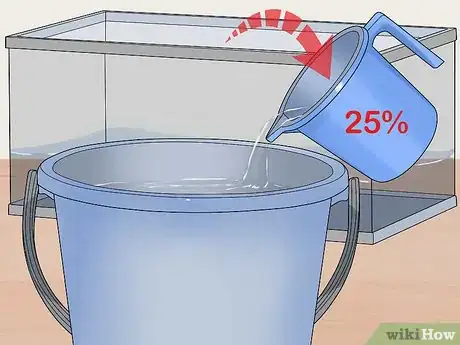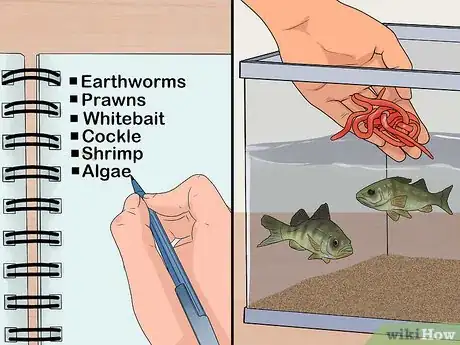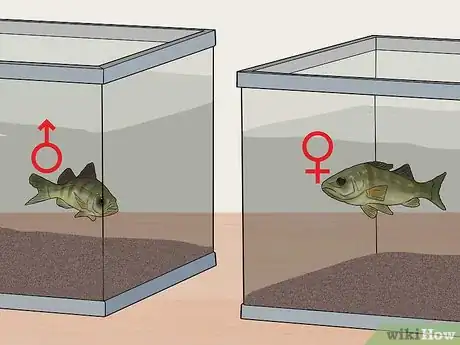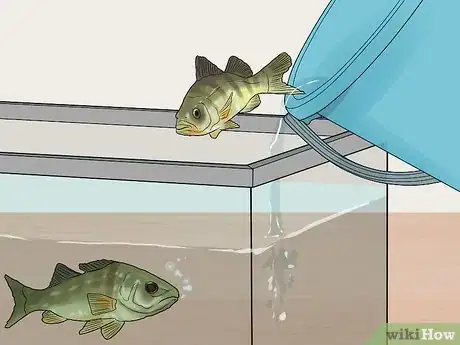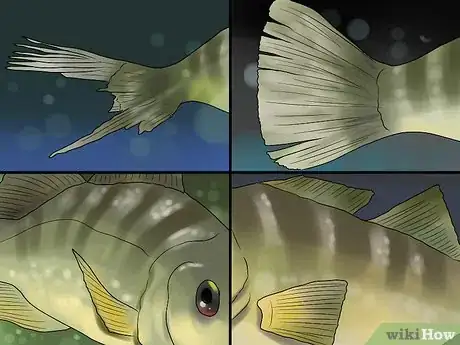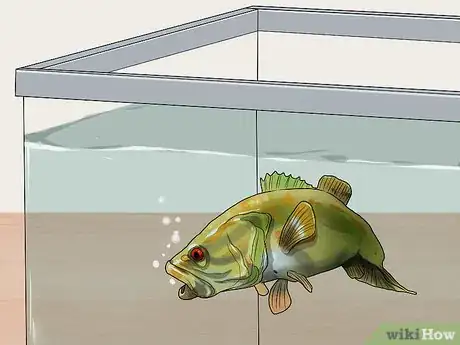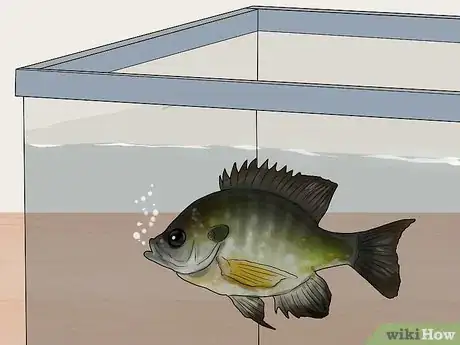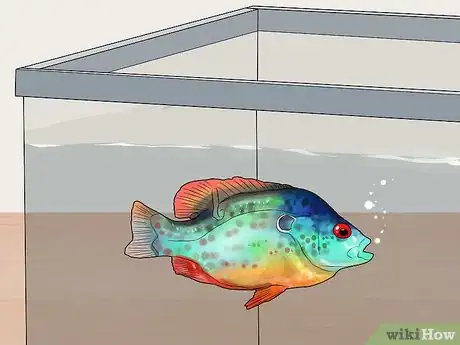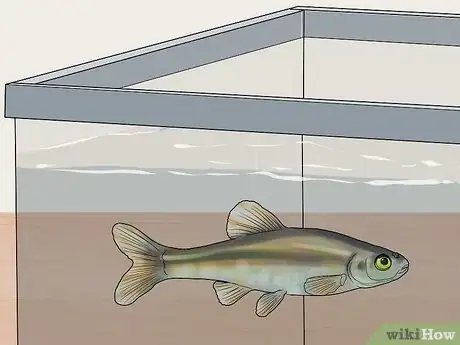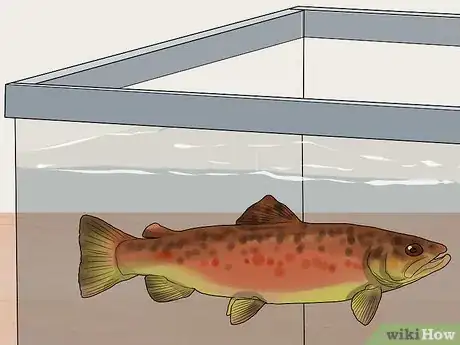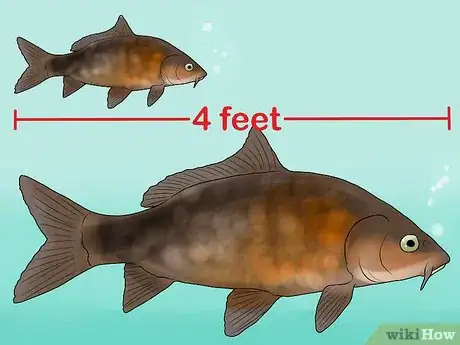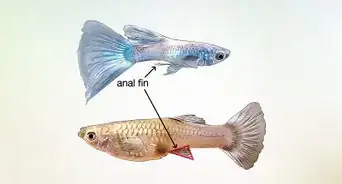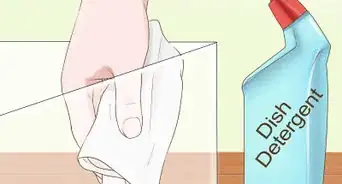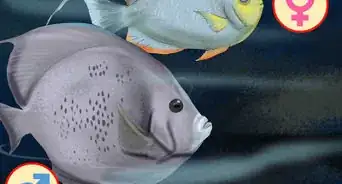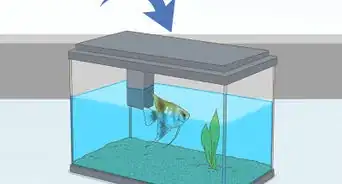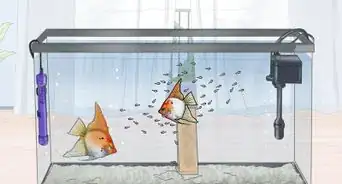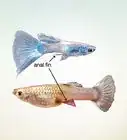This article was co-authored by Craig Morton. Craig Morton is the CEO of Aquarium Doctor Inc. based in Huntington Beach California and servicing Orange County, Los Angeles County, and the Inland Empire. With over 30 years of aquarium experience, Craig specializes in creating custom aquarium designs along with aquarium installation, service, and maintenance.
There are 13 references cited in this article, which can be found at the bottom of the page.
wikiHow marks an article as reader-approved once it receives enough positive feedback. In this case, 86% of readers who voted found the article helpful, earning it our reader-approved status.
This article has been viewed 299,020 times.
Many people don’t realize that they can stock their home aquariums with native fish, rather than exotic ones. If you’re interested in keeping American gamefish, you’ll need to procure a large tank and consider which types of fish you’d like to add to it. Learn how to maintain the tank, feed the fish, and keep them happy and healthy. Before you know it, you’ll have a thriving tank filled with resilient fish that you can enjoy for a long time!
Steps
Setting up and Maintaining the Tank
-
1Choose a tank that’s big enough to accommodate large gamefish. A 100 to 150 US gal (380 to 570 L) tank is a great size. A good rule of thumb is to keep 1 in (2.5 cm) of fish per 1 US gal (3.8 L) of water. You’ll need to account for the tank’s add-ins, like plants and structures, too, and for the fact that larger gamefish will need more room to swim. Start off small with just 2 or 3 fish and add more over time once you know there’ll be enough room.[1]
- Bass and other gamefish grow quickly and can outgrow small tanks, so consider carefully if you have a large enough space for them.
- It’s also good to start with fewer fishes so that you can get a feel for how much food you’ll need to purchase and how often you’ll need to clean the tank. Gamefish eat a lot and produce a lot of waste.
- One of the reasons why people love to keep gamefish is that it’s fun to watch them grow. Week by week, you’ll see your fish get bigger and learn more about their habits.
-
2Mimic the natural habitat as much as you can. American gamefish generally live in lakes and ponds that are filled with other creatures and objects, like driftwood, rocks, and shallow gravel or substrate. If you catch your fish in the wild, you could even add objects like small pieces of driftwood or rocks from that lake or pond to your tank. If you buy your fish, add items bought from an aquarium store so your new fish isn’t exposed to potentially dangerous bacteria.[2]
- Whether you use gravel or substrate or nothing at all is up to you. Some aquarium owners prefer to have nothing on the bottom of their tanks, as that is easier to clean. If you do add gravel or substrate, keep the level between 1 to 2 inches (2.5 to 5.1 cm) deep.
Advertisement -
3Use lighting to replicate what happens in nature. Most lakes and ponds are exposed to light for about 10 hours a day. Set the timer on your lights to turn on and off at the right times. For example, you could have the lights turn on at 7 a.m. and turn off again at 5 p.m. Even if you choose to have the light on for longer, that is okay—gamefish are very resilient and can adapt to almost any living situation.[3]
- Some American gamefish owners don’t use any lighting at all if their aquarium is located in a room that receives a lot of natural sunlight.
- As long as your fish are receiving a minimum of 8 hours of light every day, that should be enough. Even though fish caught in the wild are used to changing seasons, you don’t need to worry about restricting their sunlight during the winter and spring months.
-
4Use a chiller to keep the temperature between 55 to 70 °F (13 to 21 °C). Chillers can be expensive, but they’re the best way to ensure that the tank’s water temperature stays at the right level. Most chillers are built for a specific tank size, so double-check the capacity to ensure you’re purchasing the right chiller for your aquarium. For gamefish like trout, keep the tank cooler, around 55 °F (13 °C). For most other gamefish, a temperature range of 60 to 65 °F (16 to 18 °C) should keep your fish happy and healthy.[4]
- Some chillers also include a thermometer that tells you the actual temperature, but some don’t. If your model doesn’t have that capability, purchase a stick-on thermometer to keep on the inside of the aquarium so you can easily check the temperature.
- Although chillers are expensive, they also last for a long time, making them a worthwhile investment.
- Before purchasing any aquarium equipment, take some time to read reviews of the different products that are available.
-
5Check and clean out the filter every 3 to 4 days. Gamefish eat a lot and they produce a lot of waste. At a minimum, check the filter every 4 days. If you notice the flow of water has slowed down, chances are the filter is full and needs to be cleaned out. Some filters come with removable cartridges that you can take out and rinse, whereas other ones need to be removed completely. Always keep the instructions to your equipment so you can service things correctly.[5]
- Once you become more familiar with your fish, you’ll learn how often the filter truly needs to be changed. The fewer fish you have, the longer the filter will last between cleanings.
-
6Complete a water change once every 2 weeks. Unlike an aquarium with exotic fish, gamefish-aquarium water only needs to be changed every 2 weeks. To change the water, remove 25% to 50% of it from the tank. Test the temperature of the tank’s water and the water you’re going to add to make sure they’re the same, then add the fresh water to refill the tank.[6]
- If you have trouble remembering when it’s time to change the water, schedule the cleanings on your calendar.
Caring for the Fish
-
1Acclimate the new fish to your tank with care. Take out about 25% of the water from the fish’s bag or bucket. Replace that water with water from your aquarium. Put in another 1 cup (240 mL) of aquarium water every 10 minutes for 1 hour. Once that is done, you can transfer the fish to your tank.[7]
- Whether you caught the fish in the wild or bought it from a store, you need to take the time to introduce it to your tank appropriately so it doesn’t go into shock.
-
2Plan and execute a careful diet to keep your gamefish healthy. All gamefish will eat earthworms, prawns, whitebait, cockle, shrimp, algae, and other small creatures. Because fresh food can get expensive, try feeding them a mix of fresh, frozen, and pellet food. Feed them once a day, and give them as much food as they can eat within a 15 to 20 minute period. Try to always feed them at the same time so they can learn when to expect their food.[8]
- Many hatcheries and pet stores sell gamefish feed.
-
3Separate male and female fish to prevent overpopulation. It can be really difficult to tell the gender of a fish. If you’re buying the fish from a store or hatchery, the person selling the fish should be able to tell you, but if you need to determine the gender on your own, there are a few tips you can follow:[9]
- Check the vent of the fish, which is the opening between the anal fin and the fish’s anus. A circular vent generally indicates a male, whereas a female’s vent is more oval in shape.
- Female fish are generally much larger than male fish.
- When in doubt, ask a hatchery expert to determine if your fish is male or female.
-
4Introduce new fish one at a time to let them acclimate to each other. Gamefish, especially ones caught in the wild, are used to cohabiting with other types of fish, which means you should be able to keep a variety of species in your aquarium. But because your aquarium is smaller than their natural habitat, some fish can become territorial. Because of this, take your time when introducing new species to your tank. Add one new fish at a time, even if you already have that species in the tank, and give them a period of 3 to 4 weeks to adjust before introducing other fish. This will also give you an opportunity to make sure everyone gets along and has enough space.[10]
- If fish become aggressive with one another, you can let them fight for a little to see if the dominant fish can exert itself and the submissive fish will hopefully back down. You could also try rearranging the habitat to make different territories for the fish. Also, consider providing multiple hiding spots for attacked fish to use to take refuge. As a last resort, you may need to move one of the fish out of your aquarium or create a blocked-off area in your current aquarium using netting and put the aggressive fish into it for a week before trying to reintegrate it.
- Don’t hesitate to check out various gamefish forums to learn more about other people’s experiences—you can learn a lot from others’ successes and failures.
-
5Watch out for signs of illness or injury. Be on the lookout for tail rot, split fins, scrapes, missing scales or eyes, or torn lips—these are signs of injury. Fish that float more than they swim, that sink to the bottom of the tank, or that start hiding more than is usual might be sick. Also, if a fish stops eating, this usually indicates that it is sick or injured. If a fish is injured and needs to heal, use netting to create a cordoned section of the tank, and then let the injured fish live there for 1 to 2 weeks until it is better. If a fish is sick, you can get medication for them from the store.[11]
- Always check that your tank’s filter is running properly and that all the equipment is in good working order. Sometimes sick fish can get better after a water change or small tank adjustment.
- Sickness can spread quickly in a tank, so it’s important to catch illnesses as early as possible.
Choosing Different Types of Gamefish
-
1Keep bass in your aquarium for a lively, animated fish. Bass are very active and swim most of the day and night. They will often start to follow you along the tank once they get to know the feeding routine. Bass do grow very quickly, so try to catch or buy a smaller one, close to 3 to 4 inches (7.6 to 10.2 cm) so you can enjoy watching it grow.[12]
- Bass enjoy small insects, algae, shrimp, and bloodworms, and they also can be taught to eat flakes or pellets.
- Bass will generally eat about 2/3 of their weight every day, which means you’ll need to keep an eye out on your filter to make sure it keeps working properly.
-
2Choose freshwater sunfish for a colorful fish that’ll thrive in a tank. You can easily catch sunfish in the wild, and there are about 30 separate species. These are also great fish if you have a smaller aquarium. They’d do well in a 55 to 75 US gal (210 to 280 L) tank. Most sunfish eat insects, small fish, and crustaceans, and they don’t grow as fast as bass.[13]
- Large, adult sunfish can become territorial, so keep an eye on their behavior. If they get too aggressive, they may need to be moved into their own tank.
-
3Add the colorful pumpkinseed to your tank for an iridescent addition. If you love the look of tropical fish, the pumpkinseed would be a good choice for you as they’re the most similar in coloring. At the most, the pumpkinseed should only grow to be 9 inches (23 cm), which makes it a nice tank addition.[14]
- Pumpkinseed fish like to eat small insects, snails, and larvae. They’ll also eat shrimp, bloodworms, flakes, and pellets.
- Pumpkinseed fish can be very aggressive, so keep an eye out and remove them if they start attacking their neighbors.
-
4Pick the fathead minnow for a durable addition to your tank. They eat algae, plankton, and small insects, but they will also eat flakes, shrimp, and bloodworms. At the most, add 2 minnows per 10 gallons (38 L) of water. These are fish that can withstand a lot of changes in their environment, which makes them a nice investment for your aquarium.
- If you’re buying these fish, they’re often called “rosy reds.”
-
5Select trout for your tank if you can keep the temperature cooler. Trout need colder temperatures than most other gamefish, so they often can’t be combined with the general varieties, like bass and sunfish. Keep the temperature at 59 to 63 °F (15 to 17 °C). Trout also need a lot of strong currents, so make sure your tank is equipped to aerate the water a lot. For a 1,000 US gal (3,800 L) tank, at most you’d want to add 2 to 3 trout, so keep that in mind when choosing fish for your aquarium.[15]
- Trout like to eat leeches, bloodworms, and small insects, and they also can be taught to eat flakes and pellets.
- The brown trout and the rainbow trout are the ones most often kept in aquariums.
-
6Avoid buying or catching fish that will grow to be too large. Carp will grow to be up to 4 feet (48 in) and produce an excessive amount of waste. Alligator gar can exceed 6 feet (72 in), and sturgeon can also grow to 6 feet (72 in) and weigh over 200 pounds (91 kg). A lot of these fish would also eat their tank mates.[16]
- When in doubt, do some research or ask someone who has an established gamefish aquarium for recommendations.
Community Q&A
-
QuestionDo large mouth bass like being alone or together in a tank?
 Community AnswerWhen they are young they enjoy having a companion, but as they get older and larger they start to become more independent. But it also varies from fish to fish.
Community AnswerWhen they are young they enjoy having a companion, but as they get older and larger they start to become more independent. But it also varies from fish to fish. -
QuestionCan you order them or buy them in any type of store?
 Community AnswerPet stores do not generally sell gamefish, but they can be ordered online.
Community AnswerPet stores do not generally sell gamefish, but they can be ordered online. -
QuestionCan I have crayfish in my tank?
 Community AnswerYes, just make sure you have a large enough tank for one. Keep in mind they can be quite aggressive.
Community AnswerYes, just make sure you have a large enough tank for one. Keep in mind they can be quite aggressive.
References
- ↑ https://www.glaucus.org.uk/basshugg.htm
- ↑ https://youtu.be/4fh4mQblGrw?t=58
- ↑ https://users.cs.duke.edu/~narten/faq/hardware.html
- ↑ https://aquariumadviser.com/best-aquarium-chillers-reviews/
- ↑ http://injaf.org/articles-guides/beginners-guides/beginners-guide-to-filter-maintenance/
- ↑ https://youtu.be/4fh4mQblGrw?t=127
- ↑ https://www.fishlore.com/acclimating-tropicalfish.htm
- ↑ https://youtu.be/4fh4mQblGrw?t=374
- ↑ https://goneoutdoors.com/tell-male-largemouth-bass-female-6559436.html
- ↑ http://blogs.thatpetplace.com/thatfishblog/2012/12/13/sunfish-care-keeping-pumpkinseeds-bluegills-and-their-relatives/
- ↑ https://www.theaquariumguide.com/articles/signs-fish-sick
- ↑ https://www.glaucus.org.uk/basshugg.htm
- ↑ http://blogs.thatpetplace.com/thatfishblog/2012/12/13/sunfish-care-keeping-pumpkinseeds-bluegills-and-their-relatives/
- ↑ http://blogs.thatpetplace.com/thatfishblog/2012/12/13/sunfish-care-keeping-pumpkinseeds-bluegills-and-their-relatives/
- ↑ https://youtu.be/_52AW153YRg?t=65
- ↑ https://youtu.be/_52AW153YRg?t=123
About This Article
If you want to keep bass and other American gamefish in your area, choose a tank that holds 100-150 gallons of water. Mimic the fish’s natural habitat as much as you can by including driftwood, rocks, and shallow gravel or substrate. Since most gamefish live in deeper waters, they prefer colder temperatures, so use a chiller to keep the water in your tank between 55-70°F. Also, gamefish produce a lot of waste, so include a filter in the tank, and change out about 25% of the water once every 2 weeks. Keep reading for tips on how to feed your gamefish!

